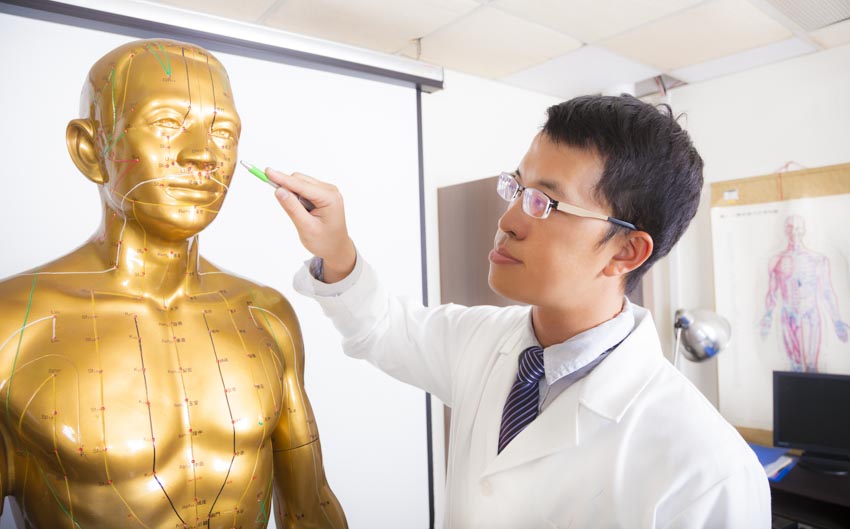
Acupuncture is effective for the treatment of Meniere's disease. Gansu University of Traditional Chinese Medicine researchers determined that acupuncture alleviates dizziness, tinnitus, and hearing loss for Meniere's disease patients. The research team documents the acupuncture methods used to achieve clinical results and the parameters used to gauge the measurements of clinical outcomes.
The warm-promotion needling method (Wen Tong Zhen Fa, 温通针法) was applied to all patients. The Dizziness Handicap Inventory (DHI), Tinnitus Handicap Inventory (THI), and Pure Tone Audiometry (PTA) scores were documented before and after treatments. The results show that all three indices improved significantly, indicating that symptoms of dizziness, tinnitus, and hearing loss were relieved significantly in all of the clinical trial patients. [1]
The study used a sample size of 30 patients, consisting of 14 males and 16 females. Age range was 31 to 56 years; the mean age was 42 ±8 years. The course of disease was 3 to 5 years, and the mean course of disease was 3.4 ±0.7 years. Upon completion of acupuncture treatment, DHI in patients decreased from 44.23 ±20.23 to 21.62 ±3.161, THI decreased from 67.42 ±3.00 to 32.28 ±4.061, and PTA decreased from 44.23 ±20.23 to 27.23 ±11.441. All three parameters demonstrated significant positive clinical outcomes.
All patients admitted to the study initially experienced a spinning sensation and feelings of ringing and fullness in the inner ears, and consequentially suffered from fatigue and stress. No patients with high blood pressure, severe disorders in the kidney and liver, cardiovascular diseases, mental disorders, and diseases of hematopoietic system were included in the research.
Sterile acupuncture needles (0.30 × 40 mm) were inserted into the following acupuncture points using various needling methods at different positions:
- GB20 (Fengchi)
- TB21 (Ermen)
- GB2 (Tinghui)
- GB8 (Shuaigu)
- GB12 (Wangu)
- TB18 (Chimai)
- GV20 (Baihui)
- EX-HN1 (Sishencong)
- LI4 (Hegu)
- LV3 (Taichong)
- LI3 (Taixi)
- KD6 (Zhaohai)
First, a seated position was taken by patients. Bilateral Fengchi was inserted using a warm-promotion needling method (Wen Tong Zhen Fa, 温通针法). This technique employs placing the pressing hand on Fengchi and applying pressure. The needling hand inserts the needle to a depth of 15 to 20 mm toward the ipsilateral levator anguli oris, a facial muscle that is lateral to the nose and attaches to the top of the lateral aspect of the mouth.
Upon achieving a deqi sensation, needles were twisted and thrust 6 times to make the insertion deep and tight. Then, needles were heavily inserted and slightly lifted 6 times. Next, needles were twisted and pressed forward consecutively, using the thumb, 6 times. Needles are kept deep and tight beneath the skin to maintain the deqi sensation and to extend this sensation to the ears. Needles were retained for 1 minute.
After completion of this part of the treatment, a supine position was taken by participants. Patients slightly opened their mouths while acupuncturists inserted needles perpendicularly at Ermen and Tinghui. Needles were retained for 30 minutes and a twisting manipulation was employed to promote a deqi sensation.
For Shuaigu, Wangu, Chimai, Baihui, and Sishencong, needles were inserted obliquely to a 10 to 15 mm needling depth. After insertion, the needle tips were adjusted to reach the aponeurosis surface and a twisting manipulation was used to promote deqi. The thumb of the needling hand was placed on the needle handle and the index finger was used to scrape the needle handle. For Hegu, Taichong, Taixi, and Zhaohai, needles were inserted perpendicularly to a length of 10 to 15 mm using a mild reinforcing-attenuating method. Needles were retained for 30 minutes.
The above treatment protocol was administered once a day, with 6 days completing one session. Patients underwent a total of 4 sessions, with a one-day break in between each session.
Reference:
[1] Qin Xianmei, Qin Xiaoguang, Cui Tiantian, Wang Miao, Treating Meniere's disease in 30 Patients with Acupuncture, Chinese Acupuncture & Moxibustion, Sep. 2021, Vol. 41 No. 9.


